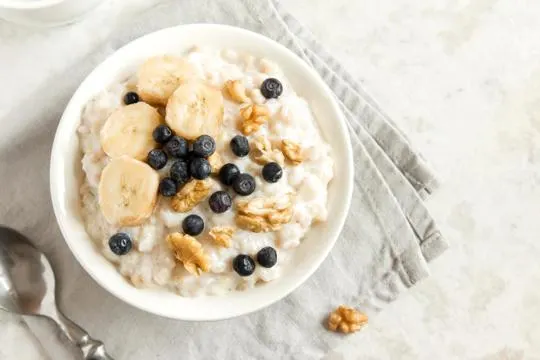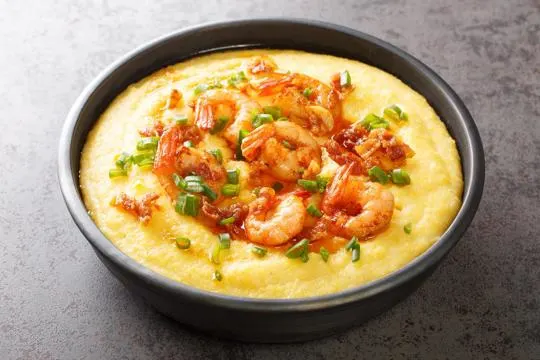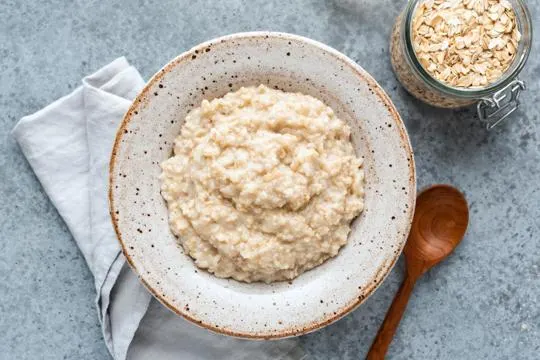Summary of key points
The main difference between grits and porridge is in the type of grain used. Grits are made from ground corn, while porridge can be made from a variety of grains like oats, rice, or wheat.
In terms of texture, grits tend to have a coarser and more grainy consistency compared to porridge. This is because cornmeal does not absorb as much liquid as other grains, resulting in a thicker and grittier final product.
In terms of flavor, grits have a distinct corn taste while porridge can take on the flavors of the added ingredients such as milk, sugar, or spices. Additionally, porridge is often cooked with more liquid compared to grits, giving it a smoother and creamier texture.
Grits and porridge sit on our breakfast tables like old frenemies. Grits sneakily originate from ground corn, while porridge humbly comes from oats. We’ve all been there, staring at our bowls and wondering, “What’s the real deal here?”
Our mornings start with this choice. It’s a showdown in the kitchen. One of us leans towards the warm, comforting embrace of porridge. Meanwhile, another swears by the creamy, savory kick of grits.
This debate goes beyond preference. It taps into our childhood memories. Remember those cold mornings? Porridge was our shield against the chill. Or those weekend family breakfasts, where grits took center stage.
Let’s dive deep. We’re uncovering the mysteries, texture by texture, flavor by flavor. No stone left unturned.
What are Grits?

Grits, my dear readers, are a staple dish in the Southern region of the United States that have become increasingly popular throughout the country.
These peculiar yet delicious grains are made from ground corn, that has been stripped of its outer bran coat, and come in various forms such as instant, quick, and old-fashioned.
The texture of grits varies depending on its coarseness, with the finer grits achieving a more creamy consistency once cooked.
Grits can be enjoyed for breakfast, lunch, and even dinner, and are often served with butter, cheese, bacon or sausage.
It’s no wonder that grits have become a must-try dish for anyone visiting the Southern States, and for those who want to indulge in a delightfully unique meal.
What is Porridge?

Porridge is a culinary delight that has been enjoyed by people all over the world for centuries.
But what exactly is it? At first glance, it may seem like a simple dish consisting of just grains and water boiled together.
However, the truth is that porridge is a complex and intricate dish that can be prepared in countless ways, using a variety of grains, sweeteners, and other ingredients.
From the Scottish oatmeal porridge to the Chinese rice congee, porridge has many different forms and is enjoyed in different ways by different cultures.
So whether you prefer your porridge savory or sweet, thick or thin, there is a perfect recipe out there for you to try.
Differences Between Grits and Porridge

Grits and porridge have a lot of variances.
Not just that, grits are coarser while porridge is smoother.
These differences make these two breakfast options unique.
Origin
Grits and porridge have origins that are steeped in tradition and culture.
Native American tribes cultivated corn, grinding it into a coarse meal to make the creamy dish we know today.
Porridge has been around for centuries, made with grains like rice, wheat, oats, or barley.
Both are warm comfort foods, yet they differ in ingredients and preparation.
Grits are made from hominy and have a coarser texture compared to porridge.
Porridge is boiled with water or milk until creamy.
Regionally, grits have special significance in Southern cuisine, often served with savory dishes.
Porridge is enjoyed around the world, with local variations and additions like fruits, nuts, spices, or sweeteners.
Ingredients Used
Grits and porridge have distinct differences.
Grits usually use ground cornmeal, while porridge often has oats or rice.
Grits are coarser than porridge, which is smoother and creamier.
The cooking method affects the flavors and textures.
So, when choosing grits and porridge, remember the ingredients make a difference.
Texture and Consistency
Grits have a unique, coarse texture and a grainy consistency that give each bite a delightful crunchiness.
Porridge, in contrast, has a smooth and creamy texture.
It’s usually made by cooking grains such as oats or rice in liquid until they’re soft and thick.
The grains break down into a velvety-smooth consistency during the stirring process.
Texture and consistency are key differences between the two dishes.
But ingredient variations and regional preferences also set them apart.
Grits are usually found in Southern cuisine, while porridge has global appeal with various regional variations such as Chinese congee and Indian kheer.
Preparation Methods
Grits and porridge? They are made differently.
Grits are a thick texture made by boiling ground cornmeal.
Porridge is a hot cereal made with grains or legumes in water or milk.
- To make grits, boil water in a pot. Slowly add the cornmeal while stirring. Cook on low heat for around 20 minutes. Add salt, butter, cheese, or other toppings to taste.
- For porridge, rinse the grains under cold water first. Bring water or milk to a boil, then add the grains. Stir occasionally. Cook until desired consistency is reached.
Grits and porridge have different preparation methods.
Appreciate the unique qualities each dish brings to your dining experience.
Flavor and Taste Comparison
Grits and porridge have their own interesting flavors.
Grits are creamy and have a slight corn flavor.
Porridge is comforting and often has a sweeter taste.
The difference?
Grits are made from ground corn kernels.
Porridge can be made from various grains like oats, rice, or wheat.
These ingredients give them their unique tastes – making a bowl of grits or porridge a special treat.
Nutritional Value of Grits and Porridge

Grits and porridge are both popular breakfast options.
Grits are made from ground corn and provide iron and vitamin B.
Porridge is an adaptable meal, which can be made from various grains.
The nutrition differs depending on the grain – oatmeal porridge is high in soluble fiber and beta-glucan, which helps lower cholesterol.
Both grits and porridge give a filling and nutritious start to the day.
Regional Variations and Culinary Uses
Grits and porridge have unique variations across cultures and regions.
Preparing these dishes in different ways adds local flavor and ingredients.
Grits, a popular Southern United States dish, is made from coarsely ground cornmeal.
It’s usually served with savory sides like bacon or shrimp.
Porridge, on the other hand, comes in many forms.
From oatmeal porridge in Scotland to congee in China, each area adds its own twist.
Grits and porridge also have distinct culinary uses.
Grits are often served as a side dish or breakfast item in the South.
Plus, they make for a great base in stews and casseroles.
Porridge is enjoyed as a breakfast option or meal with toppings like nuts, seeds, dried fruits, or even savory ingredients.
Porridge can also be a dessert, when combined with sweet spices and creamy milks.
These dishes have been embraced worldwide, highlighting the diversity of culinary traditions.
Whether you prefer grits or porridge, these meals show the cultural tapestry that surrounds our plates.
Conclusion
Overall, the differences between grits and porridge are pretty interesting.
It’s crazy that something as simple as how where it is from can make such a major difference in terms of what it looks like and how it tastes.
Not only do you get to enjoy a variety of different flavors with one recipe, but you know exactly what you are getting when you order it from restaurants or buy packaged goods at a store.
Grits are perfect for any meal, breakfast, lunch or dinner, while porridge is usually better enjoyed for breakfast or mid-day snack.
If you have never tried either one before then now is the time to try them both out and find out which one what think is the best.
Bottom line, they each hold their own spot in the culinary world depending on your personal preference so go out there and give them both a try.

Leave a comment